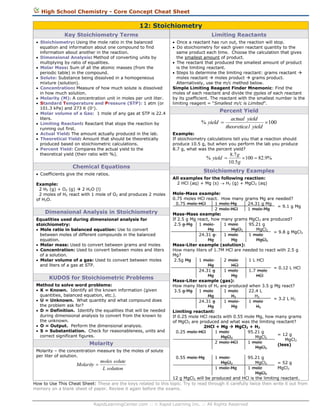
High School Chemistry - Stoichiometry Cheat Sheet
- 1. High School Chemistry - Core Concept Cheat Sheet 12: Stoichiometry Key Stoichiometry Terms Limiting Reactants Stoichiometry: Using the mole ratio in the balanced equation and information about one compound to find information about another in the reaction. Dimensional Analysis: Method of converting units by multiplying by ratio of equalities. Molar Mass: Sum of all the atomic masses (from the periodic table) in the compound. Solute: Substance being dissolved in a homogeneous mixture (solution). Concentration: Measure of how much solute is dissolved in how much solution. Molarity (M): A concentration unit in moles per unit liter. Standard Temperature and Pressure (STP): 1 atm (or 101.3 kPa) and 273 K (0). Molar volume of a Gas: 1 mole of any gas at STP is 22.4 liters. Limiting Reactant: Reactant that stops the reaction by running out first. Actual Yield: The amount actually produced in the lab. Theoretical Yield: Amount that should be theoretically produced based on stoichiometric calculations. Percent Yield: Compares the actual yield to the theoretical yield (their ratio with %). Once a reactant has run out, the reaction will stop. Do stoichiometry for each given reactant quantity to the same product each time. Choose the calculation that gives the smallest amount of product. The reactant that produced the smallest amount of product is the limiting reactant. Steps to determine the limiting reactant: grams reactant moles reactant moles product grams product. Alternatively, use the m/c method below. Simple Limiting Reagent Finder Mnemonic: Find the moles of each reactant and divide the moles of each reactant by its coefficient. The reactant with the smallest number is the limiting reagent = “Smallest m/c is Limited”. Chemical Equations Coefficients give the mole ratios. Example: 2 H2 (g) + O2 (g) 2 H2O (l) 2 moles of H2 react with 1 mole of O2 and produces 2 moles of H2O. Dimensional Analysis in Stoichiometry Equalities used during dimensional analysis for stoichiometry: Mole ratio in balanced equation: Use to convert between moles of different compounds in the balanced equation. Molar mass: Used to convert between grams and moles Concentration: Used to convert between moles and liters of a solution. Molar volume of a gas: Used to convert between moles and liters of a gas at STP. KUDOS for Stoichiometric Problems Method to solve word problems: K = Known. Identify all the known information (given quantities, balanced equation, etc.). U = Unknown. What quantity and what compound does the problem ask for? D = Definition. Identify the equalities that will be needed during dimensional analysis to convert from the known to the unknown. O = Output. Perform the dimensional analysis. S = Substantiation. Check for reasonableness, units and correct significant figures. Molarity Molarity – the concentration measure by the moles of solute per liter of solution. Percent Yield % yield actual yield 100 theoretica l yield Example: If stoichiometry calculations tell you that a reaction should produce 10.5 g, but when you perform the lab you produce 8.7 g, what was the percent yield? % yield 8.7 g 100 82.9% 10.5 g Stoichiometry Examples All examples for the following reaction: 2 HCl (aq) + Mg (s) H2 (g) + MgCl2 (aq) Mole-Mass example: 0.75 moles HCl react. How many grams Mg are needed? 0.75 mole HCl 1 mole Mg 24.31 g Mg = 9.1 g Mg 2 mole HCl 1 mole Mg Mass-Mass example: If 2.5 g Mg react, how many grams MgCl2 are produced? 2.5 g Mg 1 mole 1 mole 95.21 g Mg MgCl2 MgCl2 = 9.8 g MgCl2 24.31 g 1 mole 1 mole Mg Mg MgCl2 Mass-Liter example (solution): How many liters of 1.7M HCl are needed to react with 2.5 g Mg? 2.5g Mg 1 mole 2 mole 1 L HCl Mg HCl = 0.12 L HCl 24.31 g 1 mole 1.7 mole Mg Mg HCl Mass-Liter example (gas): How many liters of H2 are produced when 3.5 g Mg react? 3.5 g Mg 1 mole 1 mole 22.4 L Mg H2 H2 = 3.2 L H2 24.31 g 1 mole 1 mole Mg Mg H2 Limiting reactant: If 0.25 mole HCl reacts with 0.55 mole Mg, how many grams of MgCl2 are produced and what was the limiting reactant? 2HCl + Mg MgCl2 + H2 0.25 mole HCl 1 mole 95.21 g = 12 g MgCl2 MgCl2 MgCl2 2 mole HCl 1 mole (less) MgCl2 95.21 g MgCl2 = 52 g MgCl2 1 mole MgCl2 12 g MgCl2 will be produced and HCl is the limiting reactant. How to Use This Cheat Sheet: These are the keys related to this topic. Try to read through it carefully twice then write it out from memory on a blank sheet of paper. Review it again before the exams. moles solute Molarity L solution 0.55 mole Mg 1 mole MgCl2 1 mole Mg RapidLearningCenter.com :: Rapid Learning Inc. :: All Rights Reserved
